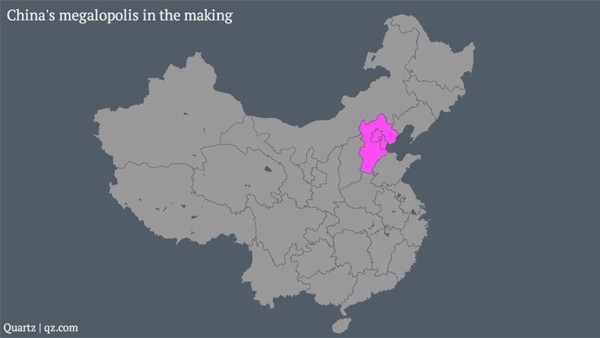The plan to establish a "super-region" which involves the integration of the capital city of Beijing, the city of Tianjin, and the province of Hebei into one megapolis called Jing-Jin-Ji will soon be officially made public, likely "as soon as the end of December," according to sources consulted by the Global Times.
The creation of the Jing-Jin-Ji region is seen as both an economic and a political or administrative move aimed at rectifying the acute and persistent problems of environmental pollution, overcrowding, water shortage, uneven development and uneven distribution of resources and opportunities within the area.
As a region, the total gross domestic product (GDP) of the area was $1 trillion last year, according to the South China Morning Post, but wealth was spread unevenly: per-capita GDP of Beijing was $15,000, while Tianjin's was $11,500 and Hebei's was only $6,300.
Covering 216,000 square kilometers and home to more than 130 million people, the Jing-Jin-Jin is actually part of the larger Bohai Bay economic zone. Once finalized, it will become China's third mega-region, following the Yangtze River Delta and the Pearl River Delta.
Previously, the Chinese leadership has already made it known that it is adapting the concept of a mega-region as a model for sustainable growth in the future and that it intends to create 10 such mega-regions around the country, including the inland areas like Shandong and Liaoning.
The plan for the integration of Beijing, Tianjin and Hebei into the Jing-Jin-Ji was actually started in 2004. However, it has not moved much beyond the drawing board until February of this year when President Xi Jinping made a call for the integrated and coordinated development of the region surrounding Beijing.
As envisioned by the National Development and Reform Commission (NDRC), the state planning agency, Beijing will have to reorganize its industry structure and provide incentives to divert some of its population to Tianjin and the neighboring cities of Hebei Province. A Beijing-Tianjin-Hebei Free Trade Zone (FTZ) may also be allowed to be set up.
At present, Beijing is dominated by state-owned enterprises and high-tech companies; Tianjin, the export gateway of the region, specializes in highly skilled manufacturing; and Hebei is known for its heavy industry like steel and concrete.
The plan is expected to address how the three political subdivisions can be expected to work together in concert.



























